Related Research Articles

Hopscotch is a popular playground game in which players toss a small object, called a lagger, into numbered triangles or a pattern of rectangles outlined on the ground and then hop or jump through the spaces and retrieve the object. It is a children's game that can be played with several players or alone.

LeapFrog Enterprises, Inc. is an educational entertainment and electronics company based in Emeryville, California. LeapFrog designs, develops, and markets technology-based learning products and related content for the education of children from infancy through grade school. The company was founded by Michael Wood and Robert Lally in 1994. John Barbour is the chief executive officer of LeapFrog.

Tag is a playground game involving two or more players chasing other players in an attempt to "tag" and mark them out of play, usually by touching with a hand. There are many variations; most forms have no teams, scores, or equipment. Usually, when a person is tagged, the tagger says, "Tag, you're 'it'!" The last one tagged during tag is "it" for the next round.

A clapping game is a type of usually cooperative game which is generally played by two players and involves clapping as a rhythmic accompaniment to a singing game or reciting of a rhyme, often nursery rhymes. Clapping games are found throughout the world and similar games may be known throughout large areas with regional variation.
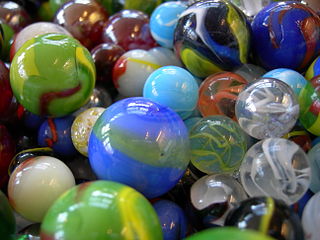
A marble is a small spherical object often made from glass, clay, steel, plastic, or agate. These balls vary in size. Most commonly, they are about 13 mm in diameter, but they may range from less than 1 mm to over 8 cm (3 in), while some art glass marbles for display purposes are over 30 cm (12 in) wide. Marbles can be used for a variety of games called marbles. They are often collected, both for nostalgia and for their aesthetic colors. In the North of England the objects and the game are called "taws", with larger taws being called bottle washers after the use of a marble in Codd-neck bottles, which were often collected for play. These toys can be used to make marble runs, a form of art, or they can be used in marble races.

A street game or street sport is a sport or game that is played on city streets rather than a prepared field. Street games are usually simply play time activities for children in the most convenient venue. Some street games have risen to the level of organized tournaments, such as stickball.

Chinese jump rope, also known as Chinese ropes, jumpsies, elastics, yoki (Canada), French skipping, American ropes/Chinese ropes, gummitwist, and Chinese garter in the Philippines is a children's game resembling hopscotch and jump rope. Various moves are combined to create Chinese jump rope patterns which are often accompanied by chants.
Chinese jump rope combines the skills of hopscotch with some of the patterns from the hand-and-string game cat's cradle. The game began in 7th-century China. In the 1960s, children in the Western hemisphere adapted the game. German-speaking children call Chinese jump rope gummitwist and British children call it elastics. The game is typically played in a group of at least 3 players with a rope approximately 16 feet in length tied into a circle. Traditional Chinese jump ropes are strings of rubber bands tied together, but today many varieties of commercial rope exist. Two players face each other standing 9 feet apart, and position the rope around their ankles so that it is taut. The third player stands between the two sides of the rope and tries to perform a designated series of moves without making an error or pausing.
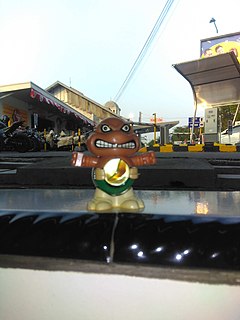
B-Daman is a marble shooting toy produced in Japan by Takara.
The following outline is provided as an overview of and topical guide to games and gaming:
Traditional Filipino games or indigenous games in the Philippines are games commonly played by children, usually using native materials or instruments. In the Philippines, due to limited resources for toys, Filipino children usually invent games without needing anything but the players themselves. Their games' complexity arises from their flexibility of thought and action.
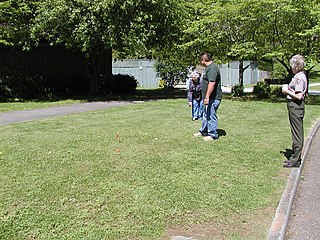
Cherokee marbles, or five hole is a traditional game among the Cherokee people of the United States, in which players roll small stone balls between five shallow pits dug into a playing field. Today, the game is commonly played with billiard balls. The game may be played in individual or team play, and in this century, has been introduced into the curricula of students attending schools in the Cherokee Nation. There is also a national tournament held annually during the Cherokee National Holiday.

A game is a structured form of play, usually undertaken for entertainment or fun, and sometimes used as an educational tool. Games are distinct from work, which is usually carried out for remuneration, and from art, which is more often an expression of aesthetic or ideological elements. However, the distinction is not clear-cut, and many games are also considered to be work or art.
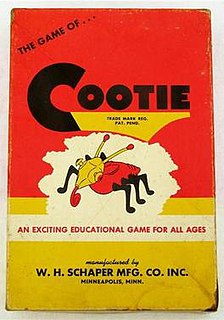
Schaper Toys, or W.H. Schaper Mfg. Co., Inc. as it was originally known, was a game and toy company founded in 1949 by William Herbert Schaper in Robbinsdale, Minnesota. "Herb" Schaper published a variety of games but was best known for having created the children's game, Cootie. Through the 1970s and 1980s, the company operated as Schaper Toys, a subsidiary of Kusan Inc. In 1986, Schaper Toys was acquired by Tyco Toys. Cootie was the company's bestseller.

The Game of Cootie is a children's dice rolling and set collection tabletop game for two to four players. The object is to be the first to build a three-dimensional bug-like object called a "cootie" from a variety of plastic body parts. Created by William Schaper in 1948, the game was launched in 1949 and sold millions in its first years. In 1973, Cootie was acquired by Tyco Toys, and, in 1986, by Hasbro subsidiary Milton Bradley. The game was given a new look and continued to enjoy commercial success. Several companies published cootie games in the first half of the twentieth century, but only Schaper's featured a free-standing, three-dimensional cootie. In 2003, Cootie was named to the Toy Industry Association's "Century of Toys List".

Duck, Duck, Goose is a traditional children's game often first learned in preschool or kindergarten. The game may be later adapted on the playground for early elementary students. The object of this game is to walk in a circle, tapping on each player's head until one is finally chosen; the chosen player must then chase the picker to avoid becoming the next picker.
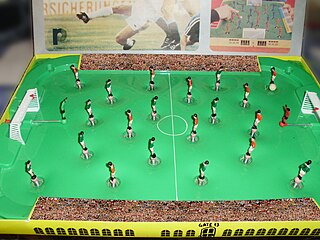
Tabletop football is a class of tabletop game simulating association football (soccer), either of the codes of rugby, or some other form of football such as American football or Australian-rules football. The games employ miniature figures of players on a bounded playing board or table that looks like a football pitch (field).

Punjabis play a wide variety of sports and games, ranging from modern games such as hockey and cricket, to the more traditional games such as Kabaddi, Kushtian (wrestling) and Khuddo khoondi. There are over 100 traditional games and sports of Punjab.
References
- ↑ Lindon, Jennie (2001). Understanding Children's Play, p.83. Nelson Thornes. ISBN 9780748739707.
- ↑ Sierra, Judy and Kaminski, Robert (1995). Children's Traditional Games, p.xii. Oryx. ISBN 0897749677.
- ↑ Sierra and Kaminski (1995), p.3.
- 1 2 3 4 5 6 7 8 9 10 11 12 13 Gryski, Camilla (1998). Let's Play: Traditional Games of Childhood, p. 5. Kids Can. ISBN 1550744976.
- 1 2 3 4 5 6 7 8 9 10 11 12 Sierra and Kaminski (1995), pp. v-vi.
- 1 2 Gryski (1998), p.10-11.
- ↑ Gryski (1998), p.15.
- ↑ Newell, W. W. (2010). Games and Songs of American Children, p. 189. Nabu Press. ISBN 978-1-145-39322-6.
- ↑ Foster, Edna Abigail; ed. (1916). Something to Do,—Boys!: A Book for Wide-Awake Boys , p. 222. W. A. Wilde. [ISBN unspecified].
- ↑ Gryski (1998), p. 26.
- ↑ "Leapfrog", Merriam-Webster.com. Accessed June 27, 2015.
- 1 2 Gryski (1998), p.16.
- ↑ Jennifer Moore-Mallinos (15 December 2018). When Competition Goes Too Far. The Rosen Publishing Group, Inc. pp. 30–. ISBN 978-1-5383-9033-7.
- 1 2 3 Schaefer, Charles E.; Reid, Steven E.; eds. (2004). Game Play: Therapeutic Use of Childhood Games, p.10. John Wiley & Sons. ISBN 9780471437338.